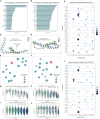AGILE platform: a deep learning powered approach to accelerate LNP development for mRNA delivery
- PMID: 39060305
- PMCID: PMC11282250
- DOI: 10.1038/s41467-024-50619-z
AGILE platform: a deep learning powered approach to accelerate LNP development for mRNA delivery
Abstract
Ionizable lipid nanoparticles (LNPs) are seeing widespread use in mRNA delivery, notably in SARS-CoV-2 mRNA vaccines. However, the expansion of mRNA therapies beyond COVID-19 is impeded by the absence of LNPs tailored for diverse cell types. In this study, we present the AI-Guided Ionizable Lipid Engineering (AGILE) platform, a synergistic combination of deep learning and combinatorial chemistry. AGILE streamlines ionizable lipid development with efficient library design, in silico lipid screening via deep neural networks, and adaptability to diverse cell lines. Using AGILE, we rapidly design, synthesize, and evaluate ionizable lipids for mRNA delivery, selecting from a vast library. Intriguingly, AGILE reveals cell-specific preferences for ionizable lipids, indicating tailoring for optimal delivery to varying cell types. These highlight AGILE's potential in expediting the development of customized LNPs, addressing the complex needs of mRNA delivery in clinical practice, thereby broadening the scope and efficacy of mRNA therapies.
© 2024. The Author(s).
Conflict of interest statement
Y.X., J.C., and B.L. have filed a provisional patent for the development of the described lipids. The remaining authors declare no competing interests.
Figures





References
MeSH terms
Substances
LinkOut - more resources
Full Text Sources
Medical
Miscellaneous

